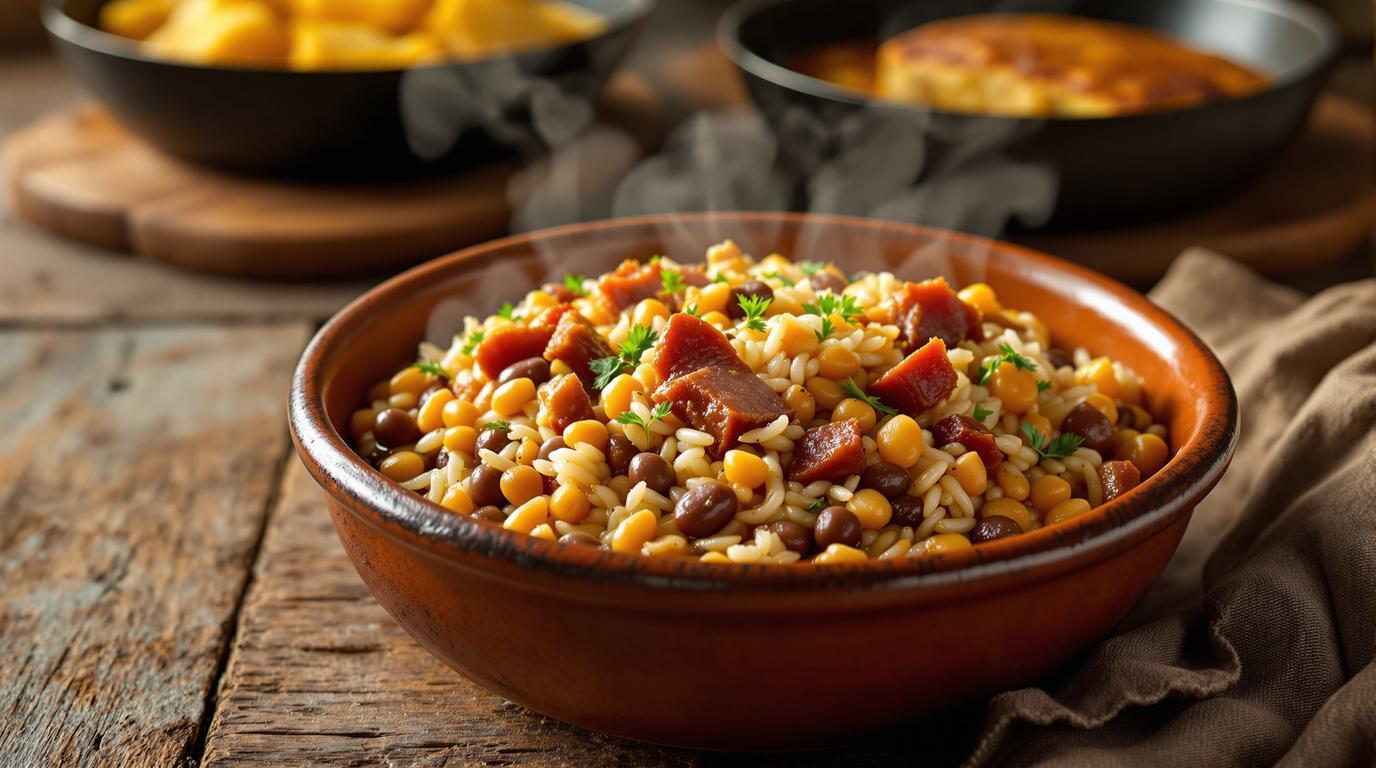There’s something deeply comforting about a steaming bowl of Hoppin’ John on a chilly evening. I first encountered this humble Southern classic during my apprenticeship at a Charleston restaurant, where the head chef—a formidable woman with hands shaped by decades of cooking—insisted we make it properly or not at all. The combination of smoky pork, earthy black-eyed peas, and fluffy rice creates a dish that’s greater than the sum of its parts. While traditionally served on New Year’s Day to bring prosperity, I find this soul-warming dish is welcome any time you need a reminder of how simple ingredients can create profound flavors.
The Story Behind Hoppin’ John 📖
Hoppin’ John traces its roots to West African culinary traditions brought to the American South by enslaved people. The dish evolved through generations, becoming a symbol of resilience and hope. Black-eyed peas represent coins, rice symbolizes abundance, and the pork signifies forward progress—all elements of the prosperity this dish is said to bring when eaten on New Year’s Day. In my grandmother’s kitchen, it wasn’t just a once-yearly tradition but a staple that sustained us through many a winter evening.
While exploring regional cuisines during my travels, I’ve noticed fascinating parallels between Hoppin’ John and dishes across the Caribbean and West Africa—a testament to our interconnected culinary heritage. For an interesting twist on another heritage dish that transforms humble ingredients into something spectacular, check out this Banana Peel Curry that similarly elevates often-discarded ingredients.
Essential Ingredients 🧾
For authentic Hoppin’ John, you’ll need:
- 1 pound (450g) dried black-eyed peas, soaked overnight
- 1 smoked ham hock (about 12 oz/340g)
- 1 medium onion, diced (about 1 cup/150g)
- 2 celery stalks, finely chopped (about ¾ cup/100g)
- 1 green bell pepper, diced (about 1 cup/150g)
- 3 garlic cloves, minced
- 1 bay leaf
- 1 teaspoon dried thyme
- ¼ teaspoon cayenne pepper (adjust to taste)
- 6 cups (1.4L) chicken stock
- 2 cups (400g) long-grain rice
- Sliced scallions and hot sauce for serving
Chef’s Note: No ham hock? You can substitute with 8 oz (225g) of diced bacon or smoked ham. The flavor profile shifts slightly, but the soul of the dish remains intact. For a vegetarian version, use smoked salt and a tablespoon of olive oil, though traditionalists might raise an eyebrow.
Step-by-Step Instructions 📝
- In a large Dutch oven or heavy-bottomed pot, brown the ham hock over medium heat until golden on all sides, about 5-6 minutes.
- Add the onion, celery, and bell pepper to the pot. Cook until softened but not browned, about 5 minutes. The vegetables should release their aromatic properties without caramelizing.
- Stir in the garlic and cook until fragrant, about 30 seconds—this brief cooking prevents bitterness.
- Add the soaked and drained black-eyed peas, bay leaf, thyme, cayenne, and stock. Bring to a gentle boil, then reduce heat to maintain a steady simmer.
- Cover partially and cook until the peas are tender but still hold their shape, about 45-60 minutes. Check occasionally, adding more stock if needed.
- Meanwhile, prepare rice according to package directions.
- Once peas are tender, remove the ham hock. When cool enough to handle, remove the meat, chop it, and return to the pot.
- Season with salt and freshly ground black pepper to taste, remembering the ham adds considerable salt.
For another technique-driven dish that rewards patient cooking, explore this Senegalese Dibi recipe, which shares Hoppin’ John’s West African culinary roots.
Chef’s Secret Techniques 🤫
The difference between good and great Hoppin’ John lies in the details. First, never rush the initial vegetable sauté—this “trinity” foundation (similar to the one used in this One-Pot Jambalaya) builds essential flavor complexity. Second, maintain a gentle simmer rather than a rolling boil—violent bubbling breaks down the peas too quickly, turning them mushy. Third, cook the rice separately and combine just before serving to prevent it from absorbing all the flavorful liquid.
For exceptional depth, add a tablespoon of apple cider vinegar in the final minutes of cooking. This brightens the flavors and adheres to the Southern tradition of including something sour on New Year’s Day to ensure a sweet year ahead.
Serving & Presentation Tips 🍽️
Traditionally, Hoppin’ John is served over rice, but I prefer folding the rice gently into the peas, allowing some grains to remain separate and others to absorb the rich pot liquor. Garnish with thinly sliced scallions for color and a fresh bite.
Serve alongside braised collard greens (representing folding money for prosperity) and cornbread (symbolizing gold). A dash of hot sauce is essential—it cuts through the richness while enhancing the dish’s earthy undertones. For dessert, something simple yet indulgent like these Fudgy Brownies provides the perfect sweet conclusion.
If you’re serving Hoppin’ John as part of a larger feast, consider adding a slow-cooked meat dish like Greek Kleftiko to create a globally-inspired meal that honors different traditions.
Remember, the beauty of Hoppin’ John lies in its accessibility and adaptability. This dish has survived generations because it welcomes interpretation while maintaining its soul. As you stir your pot of black-eyed peas, you’re connecting with countless cooks who came before—each adding their own touch to this enduring recipe. Whether you’re cooking for luck, tradition, or simply a satisfying meal, Hoppin’ John reminds us that the most meaningful dishes are often the most humble.
